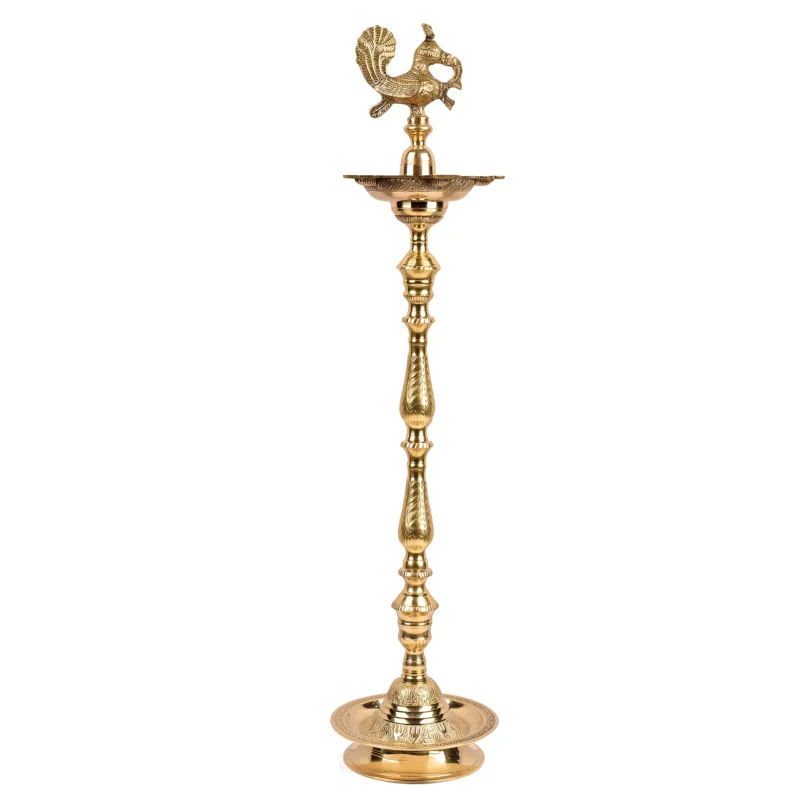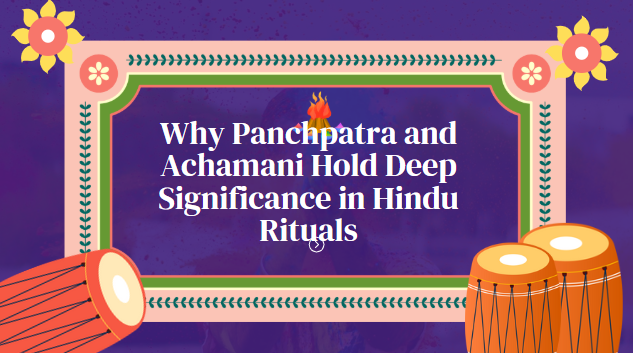The Significance of Panchpatra and Achamani: A Ritual We’ve Always Known But Rarely Talk About
Some things just feel like home. A particular smell from the kitchen, the sound of the conch during evening aarti, or the way your grandmother used to hum while lighting the diya.
And then there’s the Panchpatra and Achamani — those small but ever-present items that quietly sit beside our idols during every Puja.
They’re not flashy. They don’t take center stage. But they’ve always been there. And honestly, that’s kind of beautiful.
Today, I want to talk about the significance of Panchpatra and Achamani, not from a scholarly or priestly point of view, but from a place of memory, tradition, and meaning.
The First Thing We Touch Before a Puja Begins
Think back to your earliest memories of Puja at home. Before the incense, before the mantras, before any offering is made, there’s a moment where someone — your mother, your grandfather, maybe even you — takes a spoon, dips it into a tiny cup of water, sips a little, and gently sprinkles some around.
That’s it. No grand act. No loud declaration.
But that little action, with the Panchpatra and Achamani, is actually the beginning of everything. It’s the doorway into devotion.
The water inside the Panchpatra isn’t just water. It’s sacred. And when we sip it using the Achamani, we’re not just following a rule — we’re cleansing ourselves, preparing our mind and body to step into a sacred space.
That, right there, is the significance of Panchpatra and Achamani. It’s about intention, about presence. It’s about pausing before something meaningful.
The Things That Never Change
I remember watching my grandmother prepare for Puja every morning. It was a quiet routine — nothing dramatic. She’d bathe, wear a fresh cotton saree, tie her hair into a bun, and sit cross-legged in front of the small altar.
The Panchpatra and Achamani would already be in place. She’d pour a little Ganga jal or filtered water into the Panchpatra, take the Achamani in her hand, and begin Achamanam — a sacred sip, three times.
Even as a child, I could sense something shifted in that moment. Her posture changed. Her energy changed. It was like she stepped into another world — calmer, clearer, still.
The significance of Panchpatra and Achamani is that they become a ritual bridge. One moment you’re in the world — distracted, hurried, scattered — and the next, you’re in the presence of the divine.
All from a tiny cup and spoon.
Why These Two Matter More Than We Think
We live in a world that celebrates big gestures. But in Hindu traditions, the small things often carry the deepest meaning.
The Panchpatra symbolizes purity. It holds the sacred water — not just for drinking, but for cleansing the hands, the mouth, even the altar itself.
The Achamani is used to take that water in a respectful, measured way — a reminder that nothing in a ritual should be rushed or wasted.
When we use them together, we’re saying, “I honor this space. I honor this moment.”
And honestly, in a time when our lives are full of screens, noise, and endless scrolls, having even one moment of genuine stillness is rare. That’s what the significance of Panchpatra and Achamani gives us — a pause, a breath, a return to what’s real.
More Than Just Ritual — It’s a Feeling
I once asked a priest why we can’t just start the Puja without this step. He smiled and said, “Would you walk into a temple wearing shoes, carrying your stress, your ego, your distractions?”
It hit me then. The act of sipping water, of quietly cleansing yourself with the Panchpatra and Achamani, is like leaving your shoes outside the door of your soul.
It’s a humble act. But also a powerful one.
The significance of Panchpatra and Achamani isn’t in how expensive they are, or how decorative. It’s in how they help us step into devotion gently, respectfully, mindfully.
Where Tradition Meets Today
Maybe you’re someone just starting to build a daily Puja habit. Or maybe you’re rediscovering your connection to tradition after years of being away from it. Either way, the Panchpatra and Achamani are the perfect place to begin.
At Swastik Pooja, you’ll find exactly what you need — not just well-made copper and brass Panchpatras and Achamanis, but the kind that feel like they belong. Not flashy, not modern for the sake of being modern. Just simple, grounded, and sacred.
Because honoring tradition doesn’t mean complicating it. Sometimes, it’s as simple as holding water with both hands and saying, “I’m ready.”
Final Thoughts — It’s Always the Smallest Things
We often think spiritual growth requires something big — hours of chanting, difficult fasting, long ceremonies. But more often than not, it starts with something small.
A cup of water. A quiet sip. A moment of breath.
That’s the significance of Panchpatra and Achamani — they ground us, center us, prepare us. They help us leave behind the world for just a few minutes and meet the divine with a clean heart.
So the next time you see these little items on your Puja thali, don’t brush past them. Use them with awareness. Use them with love.
Because they’ve been patiently waiting — generation after generation — to help us come home to ourselves.
Start your sacred ritual the right way.
Find your Panchpatra and Achamani at Swastik Pooja, where tradition meets trust.
Our website
Our instagram

1 Pc Lord Ganesha Metal Diya
- Item Name: 1 Pc Lord Ganesha Metal Diya
- Material: Made of 100% Pure Virgin Metal. Sturdy, Durable and Long Lasting.
- Dimensions: Diameter: Width: 5 cm, Height: 8.35 cm.
- Weight: 70 Grams (Each Diya)
About Product: Satvik Beautiful Metal statue of Ganesh with Attached Diya in Traditional Indian style – Diwali Special Terracotta. This designer handicraft is perfect for Diwali Decoration in the Living Room, Mandir, and Dining Room You can place it at every corner of your home to feel the warmth of the festival. This handmade Diwali handicraft is very artistically designed. Diyas are an essential part of Diwali decoration. To consider this we came up with a beautiful range of Diwali Collections. You can decor your home on Diwali festival with Diya, Tea-light holders, oil lamps, earthen diya, traditional diya, natural diya, colorful diya, designer diya, clay diya, terracotta diya, plain diya, stone diya, metal diya, shadow diya, door valance, toran, rangoli, colors, puja thali, pooja thali, platter, frills, hanging ball, paper lentern, big diyas, laxmi ganesha statue, luxmi, lakshmi, lord ganesha, Ganpati, diwali pujan, deepmala. Use the above items to decorate your home

52 Inch Brass Kerala Peacock Samai Deepam Inauguration Lamp
-
Item Name: Brass Kerala Peacock Samai Deepam Inauguration Lamp 52 Inch
- Material: Made of Virgin Quality Brass
- Dimensions: Height: 121.92 cm
- Weight: 12800 Grams (Each)
- About Product: Introducing the Large Brass Kerala Peacock Diya, an exquisite masterpiece available exclusively at Satvikstore.in. This diya lamp beautifully captures the essence of Kerala’s rich artistry, adorned with elegant peacock motifs that exude grace and grandeur.
Versatile and sacred, this diya lamp is perfect for various auspicious occasions. Whether it’s an inauguration, a special event, Diwali celebrations, Mahayags, or pooja samaroh, its presence radiates positivity and bestows blessings upon the surroundings.
During the joyous Diwali festivities, the Brass Kerala Peacock Diya takes center stage in your decor, illuminating your home with a warm glow and infusing the ambiance with the spirit of the festival. Its intricate design and meticulous craftsmanship showcase the skilled expertise of Kerala’s craftsmen, elevating it to a symbol of artistic brilliance and cultural heritage.
Inspired by the grandeur of the Mahabharata era, this diya lamp becomes a captivating conversation piece, reflecting the timeless beauty of ancient Indian art and mythology. Its brass construction ensures durability, making it a cherished item that will stand the test of time, passing down the legacy to generations.
As you light the Large Brass Kerala Peacock Diya during Mahayags and pooja samarohs, its radiant glow symbolizes the divine energy, bringing spiritual enlightenment and prosperity to the rituals.
Grace your living spaces with the Large Brass Kerala Peacock Diya from Satvikstore.in. Embrace tradition and elegance, and let the grace of the peacock motifs and the spiritual significance of this diya lamp fill your home with beauty and blessings. Illuminate your life with this enchanting symbol of artistry and spirituality, available exclusively for you at Satvikstore.in.

Beautiful Roli Akshat Leaf Platter
- Item Name: Beautiful Roli Akshat Leaf Platter
- Material: Plastic
- Dimension: Height: 2.5 cm, Width: 11 cms, Weight: 25-30 Grams
About Product: Satvik Store Presents Beautiful Roli Akshat Leaf Platter. This small and adorable platter comes adorned with meenakari work and two small bowls attached for roli and akshat on leaf.

